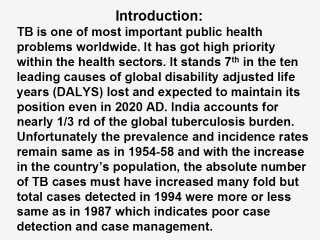| front |1 |2 |3 |4 |5 |6 |7 |8 |9 |10 |11 |12 |13 |14 |15 |16 |17 |18 |19 |20 |21 |22 |23 |24 |25 |26 |27 |28 |29 |30 |31 |32 |33 |34 |35 |36 |37 |38 |39 |40 |41 |review |
 |
Tuberculosis
in India continues to take a toll of 1,000 per day or one every minute. It
is estimated that there are 14 million TB cases in our country out of which
3.5 million are sputum positive. About 1 million sputum cases are added
every year. National Tuberculosis Control Programme was started in 1962. The
objectives of the Programme were to reduce the morbidity and mortality, to
reduce disease transmission and to diagnose as many cases of tuberculosis as
possible and to provide free treatment. However, it could not make much of
an impact on this dreaded disease. It was mainly due to incomplete treatment
as treatment completion rate was less than 40 per cent along with some other
causes such as inadequate budget; shortage of drugs; emphasis on x-ray
diagnosis; poor quality sputum microscopy and multiplicity of treatment
regimens. The crux of failure of TB control programme was:
Lack of finances c) lack of urgency to achieve control and d) lack of compliance. CONTD |